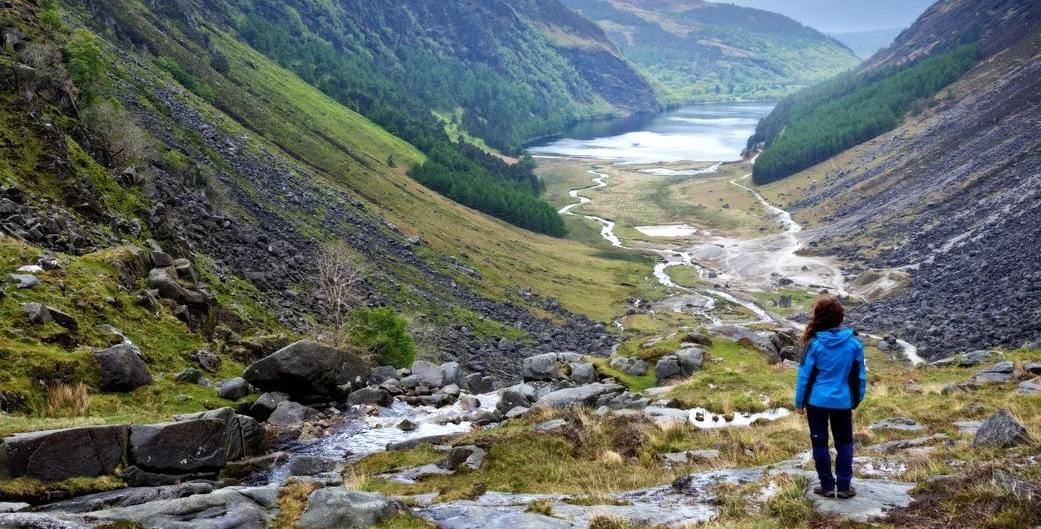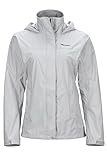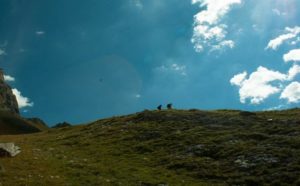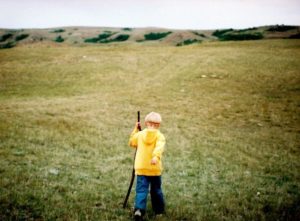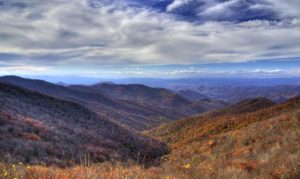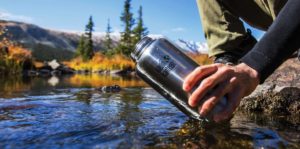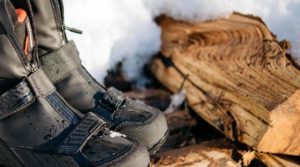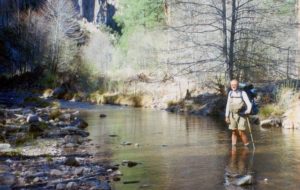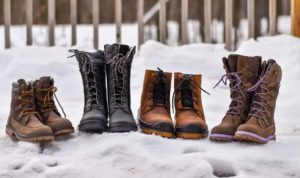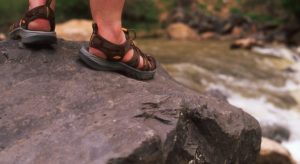What is the best rain jacket for women? We selected eleven of the top-selling rain jackets, putting them head-to-head, or hood-to-hood, in field tests. After months of extensive testing in the notoriously wet Pacific Northwest, we rated each jacket on six performance metrics, from water-resistance and breathability to packed size.
Our hope is to make sure you find the right rain shell to get you to your next summit, favorite beach, or next meeting, and keep you dry from the inside-out. Read here our men’s rain jackets review.
Best Overall Rain Jacket: Outdoor Research Aspire – Women’s
After reviewing a bunch of rain jackets, we decided to pick the Outdoor Research Aspire – Women’s as our best overall jacket. With rain shells, it is unfortunate but true that you get what you pay for. The upside is that maybe you don’t need the most expensive jacket, but that is for you to decide.
The Aspire is the full package. It inspired the most confidence in our review. When the skies are black, the Aspire has a versatile and thoughtful combination of features that keep it relatively lightweight and packable.
The Aspire is more versatile and durable than the Outdoor Research Helium II, which is a little too specific as a lightweight rain shell. For that reason, the Helium II gets our Top Pick award.
Best Value: Marmot PreCip – Women’s
The Marmot PreCip – Women’s has been well-respected for years. It has always been a top-notch performer at a reasonable price. It is comfortable, long-lasting, versatile, and will serve in just about any wet weather.
Angle-Wing construction gives it mobility, and it is light and packable for almost any backcountry adventure. NanoPro material is as breathable as fabled, though this does affect wind protection. Overall, this is the most bang for your buck and the best budget pick.
Best Ultralight Jacket: Outdoor Research Helium II – Women’s
- Ultralight
- Great protection for the weight
- Very thin, consequently not as long lasting as other models
Our choice for ultralight hiking, running, or backpacking goes to the Outdoor Research Helium II – Women’s. We found this jacket’s lightweight and packable design to be one of the most practical and useful.
This jacket provides lightweight protection from wind and rain while maintaining comfort and breathability. It is so light it functions as a wind shell but provides the added protection of a waterproof shell.
At only 5.5 ounces, it is an inconsequential addition to your pack and offers outstanding weather protection. It ran away with a high score in our rating system, but we felt it was a little too specific to be the overall winner.
It is one of the thinnest jackets reviewed, so it will not be as durable or long-lasting as the Outdoor Research Aspire. The OR nailed it with the details: they focused on making this jacket a streamlined, simple, ultralight layer — keeping it true to purpose.
Other Great Rain Jackets
As a shout out to our runners-up, we would like to direct you to more options that might be just what you need. Mountain Hardwear passed a milestone with the Mountain Hardwear Stretch Ozonic – Women’s, speeding ahead of the competition with truly, really, actually, stretchy material.
The Patagonia Torrentshell – Women’s is high quality and better optimized for mountain use than our the Marmot PreCip, plus it comes with Patagonia’s Ironclad Guarantee and the thoughtful business practices of Yvon Chouinard.
The North Face Resolve – Women’s was another one our testers really appreciated as a solid performer and a daily go-to jacket.
How to Choose The Best rain Jacket for Your Needs
The rain jacket industry has mostly mastered the art of keeping the rain out. With the rare exception, rain jackets are equally matched in the water resistance category — especially with fresh DWR (durable water repellent) coating.
The breathability category makes things interesting, though. Breathability is the Holy Grail of rainwear. This is where we found dramatic differences. The Achilles heel in this year’s lineup was in features (some wacky and silly ones!) and ruggedness (or durability). As companies strive to make rain jackets more breathable while retaining the same standard of water resistance, something has to give.
To compare the competition, we chose a range of jackets, from cheap to spendy, sexy to boxy, fully featured to minimalist. Then we put them on and ran, biked, gardened, bar-hopped, shopped, and even rode a motor scooter — all in the rain.
Below, you will find a discussion of our findings, complete with a few surprises from this year’s lineup.
This discussion will help you understand the types of shell jackets, wade through the pros and cons, and find the best one for your needs.
The first step in choosing the right jacket is to be honest with yourself: what are your priorities? Is this a jacket that will live in your closet or the trunk of your car 364 days a year? Or do you work outside most of the year? Are you sending sick mixed routes? Or will the jacket ride in the bottom of your backpack on long mountain adventures, suddenly becoming the most important item you have when the skies crack open?
Types of Rain Jackets
Two Layer Shells
The most basic rain shell is the two-layer rain jacket. These models typically have a mesh lining inside to protect the outer “face” fabric’s waterproofing/breathability. While still a breathable design (because we define breathability as a garment’s capacity to expel excess vapor from sweating), many users find this design too heavy, bulky, and generally too “warm” for aerobic activities. For this reason, these jackets are usually relegated to around-town missions where comfort is paramount.
2.5 Layer Shells
For most consumers, the 2.5-layer jacket is the gold standard in rain shell technology. It has a balance of wind and water protection in a lightweight package. Price in this category can vary a lot depending on the technology, but this is typically the category where you will find rugged garments with an emphasis on weight savings and breathability.
Price difference usually reflects how well the garment performs waterproof protection and breathability. The 2.5-layer rain shell provides the same waterproof protection as a 2-layer jacket, but is more lightweight and packable, and often feels more breathable.
Three-Layer Shells (Hardshell)
Hardshells, the more expensive weather protection, use a heavier and more durable waterproof/breathable material and are comprised of three layers (like some form of Gore-Tex). A rain shell, however, is usually comprised of two to 2.5 layers. Hardshells are appropriate for alpine and expedition use and have features tailored to this. To learn more about hard-shells see our Women’s Hardshell Review.
How We Chose the Best Rain Jackets
To evaluate the best rain shells on the market, we took eleven industry leaders into the field and subjected them to various tests. We assessed each jacket for water resistance (a must-have), breathability (the Holy Grail of rainwear), comfort, weight, durability, and packability. While personal experience is a big factor in rating any garment, our exhaustive scoring metrics take much of that bias out of the equation.
We tested a broad cross-section of jackets. The Outdoor Research Helium II – Women’s is minimalist by definition. The North Face Resolve – Women’s and the Columbia Arcadia Rain II – Women’s are cost-effective and comfortable.
The Outdoor Research Aspire – Women’s is a great all-arounder. And the Mountain Hardwear Stretch Ozonic – Women’s is a spendy but stretchy new product. The rest of the models fall somewhere in the middle: they are decently lightweight and packable while balancing performance with a few extra features.
Below you will find a description of each category we used to rate the jackets:

Water Resistance: this is what a rain jacket is all about, right?
Most rain shells, when new, are waterproof. To judge the jackets on this metric, we compared the manufacturer’s material waterproofness rating with our reviewers’ reports. Not all waterproof technology is created equal. However, in the field, how much of a difference does that number rating make? That difference shook out in our other metrics of weight and durability.
As consumers, we are concerned about how well a jacket keeps us dry. For this metric, we also considered the fit of the jacket and checked for flaws in the design that might not provide adequate coverage for the outdoor enthusiast.
Overall, the jackets kept the rain out, and we were pleased. The Outdoor Research Aspire – Women’s consistently inspired the most confidence in reviewers — it felt the sturdiest and burliest of all the jackets tested, and it is the one we would want in a torrential downpour.

Breathability
The limit to breathability is reached when the fabric wets out (i.e. after the DWR coating wears out). When this happens, the pores of the breathable fabric get clogged and you might as well be wearing a trash bag.
Realistically, no jacket (yet) hits a perfect 10 here, which would be a jacket that keeps you totally dry in a downpour and perfectly wicks away any sweat while running a marathon. Maybe we are asking too much. But demand drives ingenuity, so maybe, someday…
By definition, each of the jackets reviewed has a waterproof/breathable technology of some kind. The original waterproof/breathable rain shell was constructed with a two-layer material, like ripstop nylon coated with polyurethane and a hanging mesh lining to reduce clamminess inside. This technology is still pertinent and is what you will find in jackets like The North Face Resolve and the Columbia Arcadia II.
This technology is more breathable than old-fashioned rubber slickers, but not quite as breathable as the more modern (and rapidly evolving) 2.5-layer jackets reviewed.
Breathability is technically defined as the material’s ability to expel excess moisture vapor (sweat) and is rated using the Moisture Vapor Transmission Rate (MVTR), as discussed earlier.
However, when we say we want a breathable jacket, we mean we want it to wick sweat and dump heat ASAP. As such, ventilation is an important component, so we considered the other ways jackets were designed to breathe, such as pit-zips and mesh-lined pockets that act as vents.
Notably, the Outdoor Research Aspire takes ventilation to a new level, unzipping all the way up the sides for a poncho-like fit that releases any built-up heat quickly and effectively.
In the end, two of our breathability winners, the Outdoor Research Helium II – Women’s and the Stretch Ozonic, felt the most breathable. Their lightweight thin fabric makes them breathable and allows for functionality in even the most aerobic pursuits.
The new NanoPro™ material used in the Marmot PreCip – Women’s is one more point of discussion in the breathability category. The microporous structure of this material is air permeable and uses a proprietary blend of moisture-wicking technologies to keep you dry.

Comfort
Mobility is a large component of comfort, given that these are jackets designed for active outdoors people, doing everything from hiking and biking to climbing and skiing. This category didn’t factor into our ratings as much as water resistance and breathability, because people will desire different things in the comfort department.
Each review details comfort from an around-town perspective, but more importantly, we climbed, stretched, carried oddly shaped items, and moved in every way to assess each contender’s mobility.
The biggest factor in this category is stretch. The Mountain Hardwear Stretch Ozonic – Women’s takes over this year from the less-than-exciting Sierra Designs Stretch, and mostly excels. The trouble with this jacket, ironically, is also in the comfort department: The pit zips are an atrocity. They are half-sized, worthless as vents, and chafed our armpits.
The design of the hood can turn a great jacket into a nightmare when you put on your helmet to ride to the store or climb up a couloir. If it is too tight, it will restrict your movement from your arms to your neck and head and can greatly affect your vision.
Our last priority in regards to comfort was to look at all the niceties integrated into the jacket. A little fleece here, some extra room there; all of these things add up and turn a simple jacket into a favorite. The North Face Resolve – Women’s assembled all the right pieces to be our favorite in the comfort department.

Weight
When you’re putting all of your life in a backpack and carrying it for a week, weight and bulk quickly trump most other considerations of whether or not to bring something. We love light gear, but not at the expense of function. The Outdoor Research Helium II – Women’s is the lightest shell tested by far. At half the weight of the average contender, you won’t notice it in your pack or on your back — except when you stop to realize that you’ve been hiking for an hour in rain and you’re still dry and psyched.
A rain jacket is often dead weight in your pack. The prudent outdoors person will always carry a rain jacket. But the modern fast-and-light traveler questions this age-old wisdom. What can I leave behind? How can I shave ounces so I can carry all my gadgets and this flashy new solar charger? If you love gear, it’s not nice to tell you to get less stuff out there, so here’s another strategy: buy the latest and greatest in lightweight gear!
We tease, but it is true that technology has come a long way since the waxed canvas of the 1970s. In our younger days, our female reviewers prided themselves on toughness, grit, and the ability to carry heavy things while keeping up with the boys. Today, we see how myopic it was to measure exertion strictly by the weight of our backpacks.
Now we consider the percentage of body weight to be a more accurate way to distribute weight among members of a group. (Fun fact: 25-30% of body weight is purported to be the most efficient travel load.)
We still resist the hype of ultralight gear for reasons ranging from durability issues, high cost, and general cynicism. But increasingly, we find ourselves drawn to cutting-edge products. Overall, we appreciate the lightweight innovations in outdoor gear: less bulk and weight means we can save our toughness and grit for technical crux pitches and sub-24-hour summit sprints.
But weight savings can never trump safety and quality, especially in a rain jacket. This is why we write gear reviews. Where is the line drawn between lightweight and durability? We think the Mountain Hardwear Stretch Ozonic – Women’s is on the right track to finding this balance, once they work out the comfort glitches.
Packed Size
Similar to low-weight considerations is the small size consideration. For many backcountry enthusiasts, the rain shell is the one item we carry and rarely use. This metric considers the importance of bulk in a layer that is often just along for the ride in our pack. All of these jackets pack down into a pocket for easy stowing, and there are only minor differences in bulk.
The Outdoor Research Helium II – Women’s tops the charts in packed size, both for the tiny size and for the neat package it stuffs into. Surprisingly, the stretchy fabric of the Mountain Hardwear Stretch Ozonic – Women’s stuffed nicely into its pocket and made an impressively small package that was easy to tote anywhere and everywhere.
Durability
Is the jacket adequate to survive the rain, wind, sun, and snags of the mountains, beaches, trees, trails, and cities in our lives? If a jacket isn’t rugged enough to withstand the abuse of your favorite outdoor activity, nothing else matters. A waterproof jacket made of tissue paper that rips when you think about climbing in it won’t keep you dry with a gaping hole.
The highest scorer in this category is the burly and well-built OR Aspire. This jacket offers excellent water resistance and outstanding comfort and will last a long time. The Patagonia Torrentshell – Women’s boasts high durability, making it a rugged piece for any activity and also one that will last as long as that color scheme is in style.
Patagonia also introduces another take on durability. If you’re looking for a jacket that won’t wear out because you’re a consumer conscious of the waste generated by poorly designed, disposable outdoor clothing, Patagonia offers several ways to extend the life of your garment: they offer repair guidelines and promise no repair will void their Ironclad Guarantee. They offer a trade-in program at their store in Portland; and if all else fails, they will still recycle 100% of their handiwork — just drop it off or send it in.
Conclusion
It is important to find a jacket that matches your needs. Hinging on the climate you live in, the activities you plan to be doing, and the amount of use you hope to get out of your rain shell, there are various factors to consider. While water resistance is a must, durability, breathability, weight, and price are other important factors. We hope that our efforts will help you to choose a jacket that best suits your needs.
Lisa Mitchel

